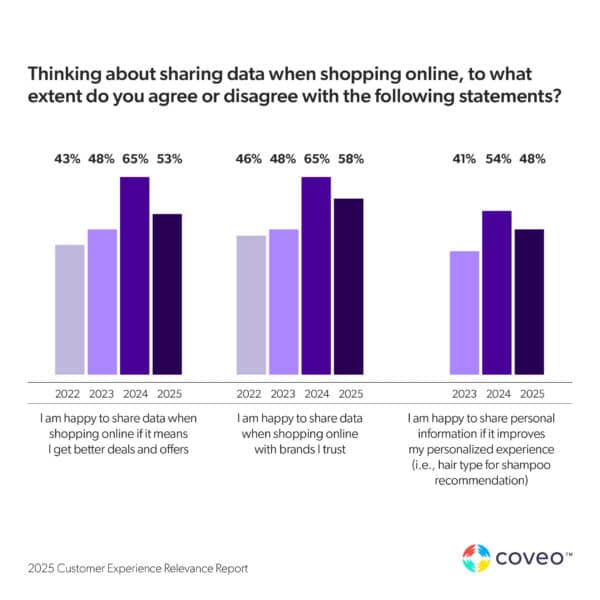
Businesses need to decrease customer effort if they want to improve the perception of their brand, and better search and AI experiences can help, according to a new report.
The “2025 Coveo Customer Experience Relevance Report” (registration required) examined evolving digital customer experiences and found room for improvement in search results, content recommendations, AI-powered self-help and inconsistent customer experiences across channels.
The report found customer effort is a significant determinant of brand perception and loyalty. In fact, 84% of respondents felt they had to put in a moderate amount or a lot of effort to find information or get help.
Nearly three-quarters (72%) of respondents said the high cost of this effort could lead to them abandoning a brand’s website for competitors or Google.
This customer friction rears its head in five significant areas mentioned in the report.
Dig deeper: How B2B and B2C brands are winning hearts with memory-driven CX
The website search experience
The report identifies search as a strategic differentiator and a primary entry point to the digital experience. When customers have a specific intent on a website, 43% go straight to the search bar. Businesses must invest in a robust, unified search experience that connects all customer journey touchpoints.
Location-aware search is a tool that can significantly enhance the customer experience. Marketing strategies can leverage location-aware search to drive both online and offline conversions.
The role of generative AI in customer experience
Generative AI presents opportunities and challenges for the customer experience. While tools like ChatGPT deliver positive outcomes, its success hinges on reliable data and seamless integration. The report said that generative search is evolving into a central driver of connected experiences, helping customers find what they need, potentially before they even realize it.
However, marketers must understand what the report calls the “Generative AI Paradox,” and balance novelty with relevance and coherence. A significant portion of respondents, 49%, have experienced AI hallucinations (fake answers) while using generative AI tools. Trust in generative AI outputs requires verification and transparency. Forty-two percent of respondents always fact-check a generated answer.
Dig deeper: Why ignoring consumers’ AI concerns is a costly mistake
Personalization in a privacy-conscious world
Personalization remains important, but reliance on direct data sharing is decreasing, the report found. While 53% of U.S. and U.K. respondents still say they are happy to share data for better deals and offers, the willingness to share data for any reason is decreasing overall.
Marketers must leverage data like on-site behavior (past searches, browsing patterns, etc.) to provide personalized and relevant recommendations without relying on explicit personal information. Customers’ ability to find what they are looking for in just a few clicks is still the factor with the most significant impact on brand perception (45%).

Self-service expectations
Self-service is gaining preference, the report found, with increased expectations for online information and assistance. While access to a live human agent remains a preferred option, there is a growing expectation for better information and self-assistance online.
This includes seeing answers directly in search results (51%), receiving helpful content recommendations (38%) and having AI-guided assistance within products (29%).
Many channels, one customer experience
Consistency across multiple customer service channels is critical, the report said, as customers use an average of three channels to engage with a company.
Inconsistent communication across departments is a major contributor to customer effort and negatively impacts brand perception. Marketing teams should ensure their efforts align with customer service strategies to ensure a seamless and consistent experience across all touchpoints.
The “Coveo Customer Experience Relevance Report 2025” surveyed two groups of 4,000 adults (age 18 or older) each across the U.S. and U.K. The first group’s responses were captured between Nov. 21, 2024 and Nov. 27, 2024, and quotas were set for gender, age and region at a country level. The second group consisted of adults who use a computer as part of their work in companies with 5,000+ employees. Their responses were captured between Nov. 21, 2024 and Dec. 9, 2024.
The post 5 areas where businesses need to improve their customer experience appeared first on MarTech.
